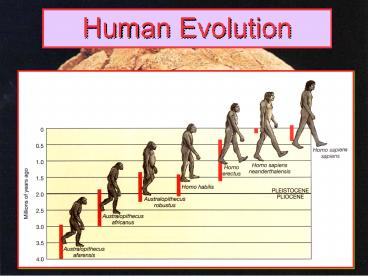Human Evolution PowerPoint PPT Presentation
1 / 12
Title: Human Evolution
1
Human Evolution
2
I. How Do We Study Human Evolution?
- Paleontologists study fossil primates and compare
them with living forms - Archaeologists and anthropologists study ancient
tools and cultures - Molecular Biologists examine DNA of different
species looking for similarities and differences
3
II. Where and When Did Humans Evolve?
- Homo sapiens evolved from ancestors we share with
other living primates (chimpanzees, apes etc.) - Homo sapiens evolved in Africa and spread around
the world - Homo sapiens first appeared 500,000 years ago
- The day before yesterday on an evolutionary
time scale - Over 60 million years after the dinosaurs went
extinct
The spread of humans over time
4
III. Characteristics of The Human Order -
Primates
- As a group, primates share several important
adaptations - Flat faces, reduced snout
- Eyes directed forward binocular vision for depth
perception see in color - Flexible fingers for grasping
- Full shoulder rotation
- Nails (vs. claws)
- Complex, large cerebrum
- Extended maternal care for young usually 1
offspring at a time 2 mammary glands - Complex social groups and behavior
5
IV. Members of the Primate Order
- Prosimians
- 1. Lemurs, lorises and aye-ayes
- Nocturnal and have large eyes well
adapted to seeing in the dark - Anthropoids (human-like primates)
- New World Monkeys
- Monkeys in Central and South America
- All are arboreal with grasping tails
- Old World Monkeys
- Baboons and macaques
- Do not have grasping tails, some are arboreal
- Great Apes (Hominoids)
- Gorillas, gibbons, orangutans, chimps and humans
6
V. Hominid Evolution
- Between 4 and 9 million years ago, the hominoid
line in Africa gave rise to a small group of
species called Hominids. - Hominid Characteristics (that distinguish them
from other hominoids) - Omnivorous
- Bipedal locomotion
- Opposable thumb
- Remarkable increase
in brain
size (cerebrum) - Compare chimp brain size (280-450 cm3) to human
brain size (1200-1600 cm3)
7
V. Hominid Evolution
- General Trends in Hominid Evolution Over Time
- Increase in brain size and body mass
- Reduction in area of lower face jaw angle size
of brow ridge - Increase in width of pelvic opening (why?)
- Presence of Brocas Area (indicates possibility
of speech)
8
VI. Hominid Ancestors
- Genus Australopithecus (Southern Ape)
- First known hominid
- Walked upright
- Four species existed
- A. boisei, A. robustus, A. afarensis and A.
africanus - Lived between 4.4 and 1.1 million years ago
9
VI. Hominid Ancestors
- B. Genus Homo
- Homo habilis (Handy Man)
- Smaller face, larger brain than Australopithecus
- Used primitive tools made of stone and bone
- Lived between 1 and 2 million years ago
10
VI. Hominid Ancestors
- B. Genus Homo
- 2. Homo erectus
- Larger brain than Homo habilis (cranial capacity
gt 800 cm3) - By 1 million years ago, they had spread from
Africa to Europe and Asia - Excellent tool maker (crafted and used hand axes)
- Used fire for cooking
- Lived in primitive huts
- Used speech to communicate
11
VI. Hominid Ancestors
- B. Genus Homo
- Homo sapiens neanderthalensis
- First discovered in the Neander Valley in Germany
- Lived between 150,000 and 30,000 years ago
- Constructed burial sites for the dead
- Wore jewelry and clothing
- Very similar to modern humans
12
VI. Modern Humans
- A. Genus Homo
- Homo sapien sapiens
- The first hominids truly identical to modern
humans appeared in Africa, roughly 100,000 years
ago and were called Cro-Magnon - Complex culture talented artists
- Wide variety of stone and bone tools spear
points, knives, chisels and needles - Lived side by side the Neanderthals in several
locations around the globe - When Neanderthals disappeared, only Homo sapiens
sapiens remained to populate the rest of the world

